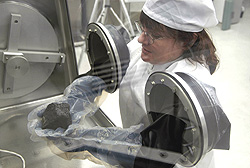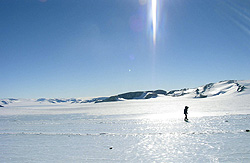| |

The meteorite as it was collected in Antarctica.
Credit: ANSMET / Case Western University
Select image for larger version
(Size: 1212KB) |
| |
| |

Meteorite MIL 03346 in the meteorite processing laboratory at the Johnson Space Center.
Credit: ANSMET / Case Western University
Select image for larger version
(Size: 669KB) |
| |
| |

A member of the 2003-2004 ANSMET team searches the Miller Range icefield in the Transantarctic mountains.
Credit: ANSMET / Case Western University
Select image for larger version
(Size: 688KB) |
| |
| |
Larger versions of all images from this document |
| |
 Note About Images Note About Images |
| |

 View video View video
This NSF animation shows how material from the surface of Mars can travel to Earth and become a meteorite.
Credit: Trent L. Schindler / National Science Foundation |
| |
| |
 View video View video
Download broadcast quality version of the NSF animation.
Credit: Trent L. Schindler / National Science Foundation |
| |
Broadcasters: Animation/B-Roll available on Betcam SP. Please contact Dena Headlee at dheadlee@nsf.gov, 703-292-7739.
ARLINGTON, Va.— While rovers and orbiting spacecraft scour Mars searching for clues to its past, researchers have uncovered another piece of the Red Planet in Antarctica.
The new specimen was found by a field party from the U.S. Antarctic Search for Meteorites program (ANSMET) on Dec. 15, 2003, on an icefield in the Miller Range of the Transantarctic Mountains, roughly 750 kilometers (466 miles) from the South Pole. This 715.2 gram (1.5 pound) black rock, officially designated MIL 03346, was one of 1358 meteorites collected by ANSMET during the 2003-2004 austral summer.
Scientists at the Smithsonian Institution's National Museum of Natural History involved in classification of Antarctic finds said the mineralogy and texture of the meteorite are unmistakably Martian. The new specimen is the seventh recognized member of a group of Martian meteorites called the nakhlites, named after the first known specimen that fell in Nakhla, Egypt in 1911.
Like the other Martian meteorites, MIL 03346 is a piece of the Red Planet that can be studied in detail in the laboratory, providing a critical "reality check" for use in interpreting the wealth of images and data being returned by the spacecraft currently exploring Mars. Following the existing protocols of the US Antarctic meteorite program, scientists from around the world will be invited to request samples of the new specimen for their own detailed research.
Thought to have originated within thick lava flows that crystallized on Mars approximately 1.3 billion years ago, and sent to Earth by a meteorite impact about 11 million years ago, the nakhlites are among the older known Martian meteorites. As a result they bear witness to significant segments of the volcanic and environmental history of Mars.
The US Antarctic Meteorite program is a cooperative effort jointly supported by NSF, NASA and the Smithsonian Institution. Antarctic field work is supported by grants from NASA and NSF to Case Western Reserve University; initial examination and curation of recovered Antarctic meteorites is supported by NASA at the Astromaterials Curation facilities at the Johnson Space Center in Houston, Texas; and initial characterization and long term curation of Antarctic meteorite samples is supported by NASA and the Smithsonian Institution at the National Museum of Natural History in Washington, D.C.
Details of the initial characterization of the specimen and sample availability are available through a special edition of the Antarctic Meteorite Newsletter, to be immediately released on the Web and mailed to researchers worldwide.
|

